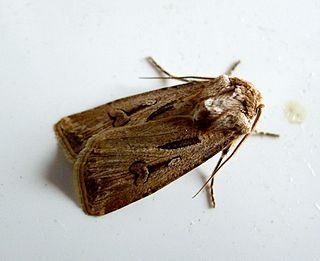
The bogong moth is a temperate species of night-flying moth, notable for its biannual long-distance seasonal migrations towards and from the Australian Alps, similar to the diurnal monarch butterfly. During the autumn and winter it is found in southern Queensland, western New South Wales, western Victoria, and also in South and Western Australia. Adult bogong moths breed and larvae hatch during this period, consuming winter pasture plants during their growth. During the spring, the moths migrate south or east and reside in mountains such as Mount Bogong, where they gregariously aestivate over the summer until their return towards breeding grounds again in the autumn.

Agrotis segetum, sometimes known as the turnip moth, is a moth of the family Noctuidae. The species was first described by Michael Denis and Ignaz Schiffermüller in 1775. It is a common European species and it is found in Africa and across Eurasia except for the northernmost parts.

The heart and dart is a moth of the family Noctuidae. The species was first described by Carl Linnaeus in his 1758 10th edition of Systema Naturae. A familiar moth to many, it is considered one of the most common of the European region. It occurs throughout the Palearctic ecozone from Ireland to Japan.

Cutworms are moth larvae that hide under litter or soil during the day, coming out in the dark to feed on plants. A larva typically attacks the first part of the plant it encounters, namely the stem, often of a seedling, and consequently cuts it down; hence the name cutworm. Cutworms are not worms, biologically speaking, but caterpillars.

Agrotis is a genus of moths of the family Noctuidae. The genus was erected by Ferdinand Ochsenheimer in 1816. A number of the species of this genus are extinct.

Agrotis ipsilon, the dark sword-grass, black cutworm, greasy cutworm, floodplain cutworm or ipsilon dart, is a small noctuid moth found worldwide. The moth gets its scientific name from black markings on its forewings shaped like the letter "Y" or the Greek letter upsilon. The larvae are known as "cutworms" because they cut plants and other crops. The larvae are serious agricultural pests and feed on nearly all varieties of vegetables and many important grains.

The Laysan noctuid moth was a species of moth in the family Noctuidae. This species is now extinct.

Agrotis puta, the shuttle-shaped dart, is a moth of the family Noctuidae. The species was first described by Jacob Hübner in 1803. It is common in the western part of Europe, but is also found in southern and central Europe, as well as North Africa and the Middle East.

The old man dart, spotted-legged cutworm or muted dart is a moth of the family Noctuidae. It is found in North America, from southern Alaska to Nova Scotia, southward into Mexico.

Agrotis cinerea, the light feathered rustic, is a moth of the family Noctuidae. The species was first described by Michael Denis and Ignaz Schiffermüller in 1775. It is found in southern and central Europe, northern Turkey, the Caucasus, western Turkmenia and central Asia.

Agrotis volubilis is a moth of the family Noctuidae. It is found in North America, from Newfoundland to British Columbia in Canada and in the United States from Maine to Florida and west to the West Coast.

Agrotis gladiaria, the swordsman dart or claybacked cutworm, is a moth of the family Noctuidae. It is found in south-eastern Canada from Nova Scotia to Ontario and in the United States from Maine to the panhandle of Florida, west to eastern Texas, eastern Kansas, eastern Nebraska, southern Wisconsin and Michigan.

Agrotis spinifera, or Gregson's dart, is a moth of the family Noctuidae. The species was first described by Jacob Hübner in 1808. It is found in southern Europe, Arabia to southern Africa, Madagascar, Turkey, Iraq, Iran, Afghanistan, Pakistan, Kashmir, India to Myanmar and Sri Lanka.

Lacanobia splendens, the splendid brocade, is a moth of the superfamily Noctuoidea. The species was first described by Jacob Hübner in 1808. It is found in temperate Europe and Asia up to the Pacific coast and Japan.

Agrotis trux, the crescent dart, is a moth of the family Noctuidae. The species was first described by Jacob Hübner in 1824. It has a circum-Mediterranean distribution and is found along the coasts of France, Ireland, England, southern Europe, Algeria, Syria, Iraq, Iran, southern Russia and the Arabian Peninsula. In Africa, it is found as far south as South Africa.

Agrotis bigramma, the great dart, is a moth of the family Noctuidae. The species was first described by Eugenius Johann Christoph Esper in 1790. It is found from along the southern shores of the Baltic Sea to China, the Levant and North Africa. Migrants have been reported as far west as Great Britain with three in one trap at St Agnes, Isles of Scilly on 10 August 1997.

Agrotis obesa is a moth of the family Noctuidae. It is found from south-eastern Europe, the Near East and the Middle East to China. In North Africa, it is known from Morocco to Algeria.

Agrotis graslini, or Woods's dart, is a moth of the family Noctuidae. The species was first described by Jules Pierre Rambur in 1848. It is known from coastal dunes in the western Mediterranean region. It was found on Jersey in 2001. Further investigations revealed that the species had been present there since at least 1995.

















